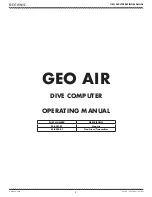
7
Principles of Operation
The detector's raw output signal is processed through several stages of software in the X96S.
Some of the more significant stages of signal processing are:
•
Units Conversion – conversion of counts into user-selected level units
•
Measurement Range – 4-20 mA output defined by the user-selected range in user-selected units.
•
Digital Filtering – signal smoothing to reduce statistical radiation noise
•
Dynamic Tracking – quick gage response to quick process changes.
•
Source Decay Compensation – automatic compensation for the radioisotope decay
•
Calibration (Referencing) – calibration of gage to user process.
The Calibration (or Referencing) procedure relates detector output (in counts) to numeric values that
accurately represent the actual process level.
The level algorithm used by the X96S software is a simple transfer function. That is, the relationship
between the detector output and the process level is mathematically expressed as:
(
)
×
−
+
=
−
−
0
0
0
0
L
L
I
I
I
I
L
Level
f
f
Where:
I
f
= detector signal with calibrate (full) level (L
f
) in vessel
I
o
= detector signal with reference (low) level (L
0
) in vessel
I = current detector signal
L
0
= level @ reference (low level)
L
f
= level @ calibration (high level)









































